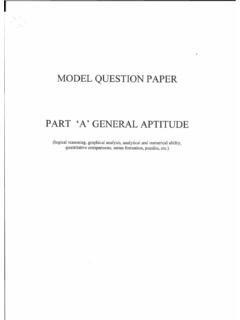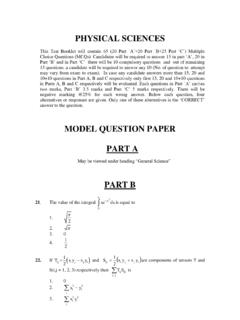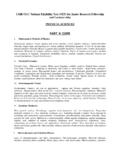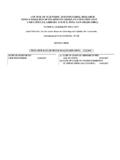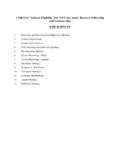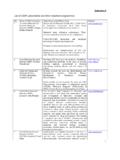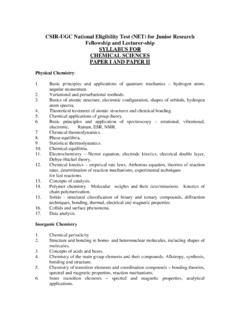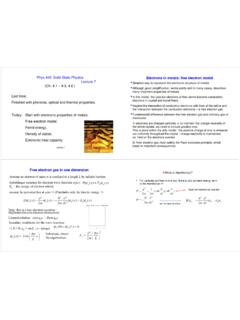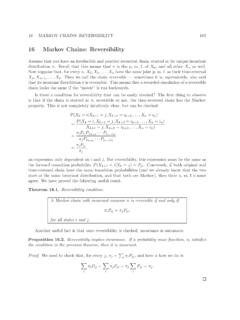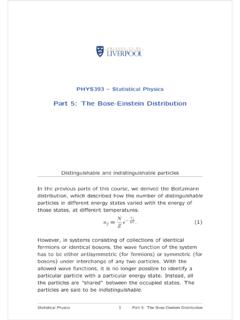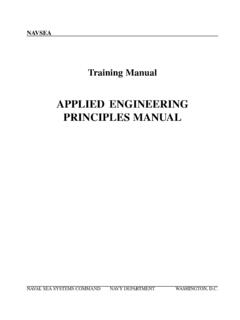Transcription of CSIR-UGC National Eligibility Test (NET) for Junior ...
1 CSIR-UGC National Eligibility Test (NET) for Junior Research Fellowship and Lecturer-ship CHEMICAL SCIENCES Inor ganic Chemistry 1. Chemical periodicity 2. Structure and bonding in homo- and he teronuclear molecules, including shapes of molecules (VSEPR Theor y). 3. Concepts of acids and bases, Hard-Soft a cid base concept, Non-aqueous solve nts. 4. Main group elements and their compounds: Allotropy, synthesis, structure and bonding, industrial importanc e of the compounds. 5. Transition elements and coordination compounds: structure, bonding theories, spectral and magne tic pr operties, reaction mechanisms. 6. Inner transition elements: spectral and magnetic pr operties, redox che mistry, ana lytical applications. 7. Organometallic compounds: synthesis, bonding and structure, and reactivity. Organometallics in homogeneous catalysis.
2 8. Cages and metal clusters. 9. Analytical che mistry- sepa ration, spectroscopic, electro- and thermoanalytical methods. 10. Bioinorganic chemistry: photosystems, porphyrins, metalloenzymes, oxygen transport, electron- transfer reactions; nitrogen fixation, metal complexes in medicine. 11. Characteris ation of inorga nic compounds by IR, Raman, NMR, EPR, M ssbauer, UV-vis, NQR, MS, e lectron spectroscopy and microscopic techniques. 12. Nuclear che mistry: nuclear reactions, fission and fusion, radio-analytical techniques and activa tion ana lysis. Physical Chemistry: 1. Basic principles of quant um mecha nics: Postulates; operator algebra; exactly- solvable systems: pa rticle-in-a-box, harmonic oscillator and the hydrogen atom, including shapes of atomic orbitals; orbital and spin ang ul ar momenta; tunneling.
3 2. Approximate methods of quantum mecha nics: Variational principle; perturba tion theory up to second order in energy; applications. 3. Atomic structure and spectroscopy; t erm symbols; many-electron systems and antisymmetry principle. 4. Chemical bonding in diatomics; elementary concepts of MO and VB theor ies; Hucke l t he ory for conjugated -electron systems. 5. Chemical applications of group theor y; s ymmetry elements; point groups; cha racter tables; selection rules. 6. Molecular spectroscopy: Rotational and vibrational spectra of diatomic molecules; electronic spectra; IR and Raman activities selection rules; basic pr inciples of magne tic resonance. 7. Chemical the rmodynamics: Laws, state and path functions and their applications; thermodynamic de scription of various type s of processes; Maxwell s relations; spontane ity and equilibria; t emperature and pressur e de pe ndenc e of thermodynamic quantities; Le Chatelier principle; elementary description of phase transitions; phase equilibria and phase rule; the rmodynamics of ideal and non-ideal gases, and solutions.
4 8. Statistical t he rmodyna mics: boltzmann distribution ; kine tic theory of g ases; pa rtition functions and their relation to thermodynamic quantities calculations for model systems. 9. Electrochemistry: Nernst equation, redox systems, electrochemical cells; Debye- Hucke l t he ory; electrolytic conductance Kohlrausch s law and its applications; ionic equilibria; conductometric and potentiometric titrations. 10. Chemical kine tics: Empirical rate laws and temperature de pende nc e; complex reactions; steady state appr oximation; determination of reaction mecha nisms; collision and transition state theor ies of rate constants; unimolecular reactions; enz yme kinetics; salt effects; homogene ous catalysis; photochemical reactions. 11. Colloids and surfaces: Stability and properties of colloids; isothe rms and surface area; heteroge ne ous catalysis.
5 12. Solid state: Crystal structures; Bragg s law and applications; band structure of solids. 13. Pol ymer chemistry: Molar masses; kinetics of polymerization. 14. Data analysis: Mean and standard deviation; absolute and relative errors; linear regression; covariance and cor relation coe fficient. Organic Chemist ry 1. IUPAC nomenclature of orga nic molecules including regio- and stereoisomers. 2. Principles of stereoc hemistry: Configurational and conformational isomerism in acyclic and cyclic compounds; stereogenicity, stereoselectivity, ena ntioselectivity, diastereoselectivity and asymmetric induction. 3. Aromaticity: Benz enoid and non-be nzenoid compounds generation and reactions. 4. Organic reactive intermediates: Generation, stability and reactivity of carbocations, carbanions, free radicals, carbene s, benz yne s and nitrene s. 5. Organic reaction mecha nisms involving addition, elimination and substitution reactions with electrophilic, nucleophilic or radical species.
6 Determination of reaction pathways. 6. Common named reactions and rearrange ments applications in organi c synthesis. 7. Organic transformations and reage nts: Functional group interconversion including oxidations and reductions; common catalysts and reagents (organic, inorganic, or ga nometallic and enz ymatic). Chemo, regio and stereoselective transformations. 8. Concepts in organic synthe sis: Retrosynthesis, disconnection, synthons, line ar and convergent synthesis, umpolung of reactivity and pr otecting groups. 9. Asymmetric synthesis: C hiral auxiliaries, methods of asymmetric induction substrate, reagent and catalyst controlled reactions; determina tion of ena ntiomeric and diastereomeric excess; enantio-discrimination. Resolution optical and kinetic. 10. Pericyclic reactions electrocyclisation, cycloaddition, sigmatropic rearrangements and other relat ed concerted reactions.
7 Principles and applications of photochemical reactions in organi c che mistry. 11. Synthesis and reactivity of common heterocyclic compounds containing one or two heteroa toms (O, N, S). 12. Chemistry of natural products: Carbohydrates, proteins and peptide s, fatty acids, nucleic acids, terpene s, steroids and alkaloids. Biogenesis of terpenoids and alkaloids. 13. Structure de termina tion of organic compounds by IR, UV-Vis, 1H & 13C NMR and Mass spectroscopic techniques. Interdisciplinar y topics 1. Chemistry in nanoscience and technology. 2. Catalysis and green chemistry. 3. Medicinal che mistry. 4. Supramolecular che mistry. 5. Environmental che mistry.
